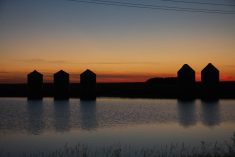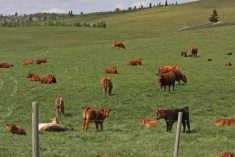YORKTON, Sask. – The draft horse played an integral role in prairie his-t ory, and Merlin Ford hopes to chronicle that role in a new book.
“It’s an interest I’ve had for quite a while,” said Ford, who lives near Kuroki, Sask.
Ford’s family bought its first draft horses when he was 14, and he began showing them a year later.
“When I was a kid, I remember going to visit my aunt and uncle (Graham and Linda Thomson). They always had a team of Percheron geldings,” he said.
Read Also

Know what costs are involved in keeping crops in the bin
When you’re looking at full bins and rising calf prices, the human reflex is to hold on and hope for more. That’s not a plan. It’s a bet. Storage has a price tag.
The idea of a book began a couple of years ago.
“I got wondering about how draft horse numbers have changed over the years,” he said.
Ford said 5,000 Percherons were registered in the United States in 1936. By 1954 it was 54.
Ford said the decline came into sharper focus when a friend went on a genetics search.
“A friend was looking for a Belgian stallion and his options in Saskatchewan were getting really thin.”
So Ford wrote an article on the decline of draft horses. He quickly realized there was much more story to tell and the idea of the book was born.
The initial idea was to highlight important Saskatchewan families who played a role in draft horses over the years. However, that idea was soon abandoned.
“There was too much time to cover, and too many people,” he said.
Fortunately he found good contacts, including Eddie Arnold of Shoal Lake, Man., whom he met at Canadian Western Agribition in 1989. The friendship lasted until Arnold’s death in 2005.
“He lived to be just shy of 107,” said Ford.
Arnold shared dozens of stories about horses, in particular those of Saskatchewan horses doing well in the show ring at the Toronto Royal and at a major show in Chicago.
“I never met anyone with a memory like that,” said Ford. “The number of people familiar with this stuff is dwindling as time goes by.”
Ford eventually decided to write about the varied roles horses filled over the years.
“I was looking at all the jobs horses did. There were a whole bunch many people had probably never seen.”
Ford said most people are familiar with horses doing farm work, pulling plows and binders and running threshing machines, but they also did city jobs. Almost everything that moved was moved with horses. Goods arrived by train and were then taken to stores and homes by wagons drawn by draft horses.
Ford said his book will focus on draft breeds, predominantly Belgians, Clydesdales and Percherons, but will also include Suffolk and Shire.
A stud book at the University of Saskatchewan listed only 700 Suffolk from 1907 to 1939.
“And those were the good times (of horse numbers).”
Ford said he will keep stories short, relying on the photos to draw attention and hold interest. He is looking for more photos of draft horses doing jobs within an urban setting. He said tracing families involved in using horses in cities and towns is harder.
For more information, visit www.clippityclop.ca, e-mail clippity. clop1@gmail or phone 306-338-2132.














